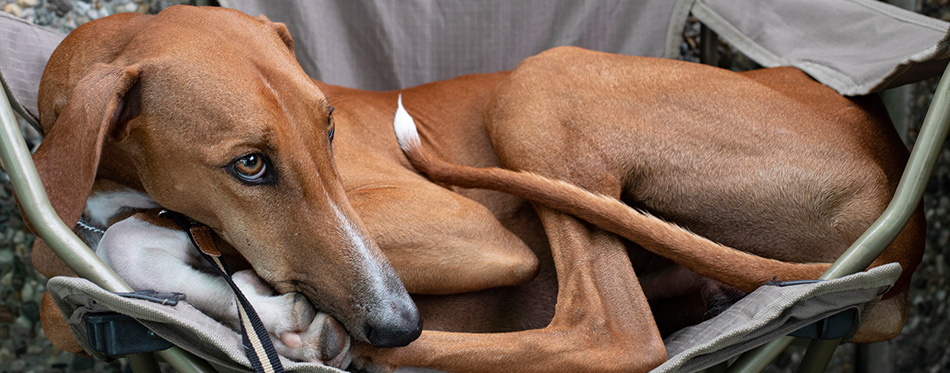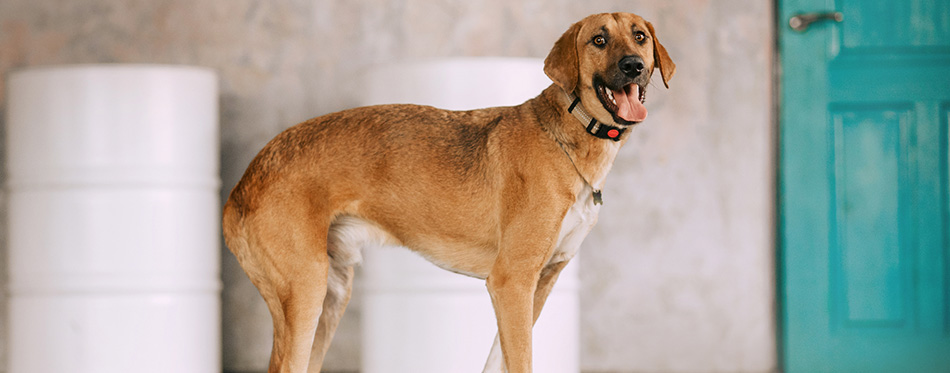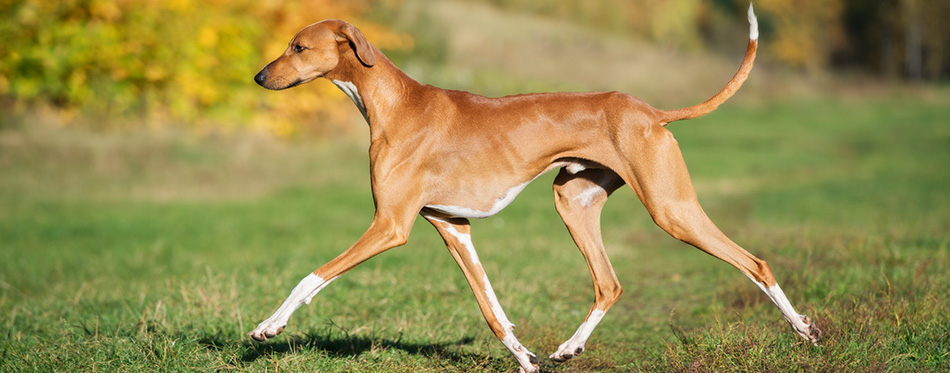The pride of the nomadic tribes of West Africa, the Azawakh is an elegant and ultra-sleek dog bred for protecting its family. It is a hunter by nature, using its remarkable endurance, high energy, and speed to catch prey. It works well with its fellow Azawakhs and their human families. It is quiet to live with and beautiful to behold. However, the Azawakh is not a dog for every home.

History of the Azawakh Dog
The exact origins of the Azawakh remain disputable to this day. While the exact timeline of its breeding is in question, there is no doubt that the dog comes from the Sahel region of West Africa. Nomadic peoples, like the Tuareg and Fula, bred the dog to help guard their tents from attackers. Azawakhs also served as pack hunters, working with other Azawakhs and their human hunting partners in going after gazelles and hares. The Tuareg nomads call the Azawakh, the “idii n’ illeli”. This translates to “sighthound of the free people”.
The ancestors of the Azawakhs were sub-Saharan pariah dogs. They look like Greyhounds, although their closest relative is the Sloughi. While the Azawakh shares many physiological characteristics with other sighthounds, recent evidence shows that it is more related to Italian wolves, jackals, foxes, and the Sloughi. What this suggests is that the ancestors of the Azawakh may have differentiated from other dog populations.
Archeologists were also able to unearth rare 8,000 to 10,000-year old petroglyph rock art depicting slender and long-legged dogs running along with human hunters. Ancient Saharan settlements during the Neolithic and Holocene Subpluvial also revealed dog bones.
The geographical isolation of the Sahel region meant that the pariah dogs were free from foreign interference. The Azawakh you see today are the same pariah dogs that ancient people had in their tribes. The nomads of the Sahel did not breed their dogs according to western standards. They do not select their canines based on its color or some other distinguishing feature. As such, one can always find very elegant Azawakh puppies among rustic siblings. They also do not separate a noble dog (al hor) from a mongrel (kelb). This results in breed resilience and genetic variability.
The Azawakh is not common outside Africa, although the very first dog to ever get outside its borders was in the 1970s, reaching Europe. A decade later, the very first Azawakh reached American shores. In October 1987, the very first Azawakh litter was born in the US. The puppies had fawn coat color with white markings.
In 1993, the Azawakh received its recognition from the United Kennel Club. The American Kennel Club, for its part, put the breed in its Foundation Stock Service in 1997. In 2011, the AKC moved the Azawakh to the organization’s Miscellaneous Class. It is now part of the AKC Hound Group.
Registering the Azawakh with the FCI can be made through the Federacion Canofilia de Puerto Rico. Azawakh owners in the US can also register their dog with the American Rare Breed Association and the United Kennel Club.
Quick Facts about the Azawakh Dog
The Azawakh is elegant and tall like its cousin, the Sloughi. It is a formidable pack hunter but its true passion is guarding its family. You have read only a few of the factual information that you have to know about the Azawakh. Here are the other facts.
A Leggy and Skinny Sighthound
Like other sighthounds, the Azawakh is a very leggy breed. It can be as tall as 24 to 29 inches at the withers and weigh between 33 and 55 pounds. Males tip the scales at 44 to 55 lbs while females come in at 33 to 44 lbs.
The Azawakh has longer hind legs than forelegs. This allows it to run at incredible speeds. This also makes the hips of the Azawakh higher than its shoulders. One thing you will notice about the Azawakh is that it has “flat” muscles; they do not “bulge”. This is unlike the Whippet and the Greyhound that can have muscle forms showing underneath their skin. The bones are also noticeable in the Azawakh.
A Fast and Agile Sighthound
There is a reason why the Azawakh has a very sleek profile. It needs to chase hare and gazelles up to speeds of 40 MPH. The Saluki has a top speed of 43 MPH while the Greyhound tops out at 45 MPH. It is not as fast as the Greyhound, but there is another trait that works well for the Azawakh.
This breed is a long-distance runner. It can run for miles nonstop and without ever tiring. Its long hind legs and aerodynamic body also allow it to make sudden changes in its direction. One has to understand that gazelles have a knack for zipping through the open fields.
It is the Archetypal Pack Dog
Azawakhs are unlike other sighthounds in many ways. The most remarkable characteristic that distinguishes them from other breeds is their strong pack instincts. These are dogs that love to hunt as a group. They will tire their prey and kick it with their hind quarters when they catch up with them. Because of this pack behavior, many say they act like very leggy Beagles. These little dogs are very efficient pack hunters as well. The only difference is that they are scenthounds, not sighthounds.
As pack dogs, Azawakhs form very complex social structures and hierarchies. In the Sahel region, only the Alpha can serve as the sire. When in a hunt, the Alpha leads with the others close. The same is true when serving as watchdogs for the whole community of nomads. Every single Azawakh knows its role in keeping the tribe safe while they sleep at night.
Azawakh dogs display a remarkable memory. They recognize their “packmates” even after a long period of separation. When not guarding the tribe at night, some of these dogs sleep on top of each other. They do this to help them protect the vulnerable from the cold as well as for companionship.

Have a Very Strong Guarding Instinct
The Tuaregs and other sub-Saharan nomads used Azawakhs to protect their encampment at night. These dogs do not need to “smell” the scent of danger in the air. All they need is their remarkable eyesight, long legs, and long necks. In the desert, there aren’t many trees and bushes for predators to hide. As such, the Azawakh can see any movement from great distances.
People say that the Azawakh is so protective of its family that a leaf flying in the wind is often enough to trigger a chase. They are always on the alert for anything that moves.
Very Loyal, Yet Standoffish
Because of the Azawakh’s close relationship with its people, it forms a very strong and deep bond with them. One can never question the loyalty of an Azawakh. For this breed, there is nothing greater than being with its family.
This is bad news for strangers, intruders, and anyone else in between. Azawakhs display an aloof demeanor when in the company of strangers. It is not aggressive, but it will never hesitate to pounce or let out a growl if it senses something amiss.
Things You Should Know
As mentioned, the Azawakh is not for every home. It is a very unique breed that dislikes the cold and prefers people with very active lifestyles. If you’re thinking of including an Azawakh in your growing family, here are things you ought to know.
Health
Azawakhs are a healthy breed of dog. In their native land, the most common health concern is injuries from their coursing activities. Their injuries heal very fast, however. Hip dysplasia is also uncommon in the breed. People attribute this to the lightweight nature of the dog, eliminating the strain on its hip joints.
However, some dogs can have Wobbler disease. This is a health condition whereby there is instability in the dog’s vertebra. It is quite rare in the native Azawakh, however. The disease is more common in western-bred Azawakhs because of improper dietary practices. Some Azawakhs can also develop idiopathic epilepsy.
One thing that you should be wary about is the tendency of the breed for gastric torsion. It has a deep chest, which is one of the risk factors for gastric dilatation volvulus. One has to be very mindful of feeding the Azawakh.
Related Post: Dog Joint Supplements
Feeding
There are two health conditions that proper feeding practices can correct in the Azawakh. First, puppies should get only the right amounts of protein in their diet. Too much protein will facilitate in a growth spurt that is too fast for the puppy’s own good. This can result in the improper alignment of the spine, causing Wobbler syndrome. One also has to understand that the Azawakh does not have well-defined muscles. Hence, its protein requirements are often lower than other, ‘more muscled’ breeds.
Second, feeding the Azawakh twice or three times a day is crucial in the prevention of gastric torsion. Deep-chested breeds can benefit from small, frequent feedings instead of a single large meal. This minimizes the amount of air that the dog will introduce into its stomach.
High-quality, complete, and well-balanced dog food is a must for the Azawakh. Because this is a rare breed in the western world, one should always coordinate with his or her veterinarian regarding the nutrition of the dog.
For more guides on choosing the right dog food, you may wish to check out our reviews of the best dry dog food, organic dog food, grain free dog food, vegan dog treats and pig ears for dogs.
Care
Caring for the Azawakh is not difficult. There are a couple of things you need to understand, though. This dog needs at least 30 minutes of exercise every single day. However, you have to bring it out of the home and exercise with it. Letting the dog out into your backyard so that it will run and exercise on its own is not a good idea. It is not in the dog’s nature to perform something it doesn’t think is “work”. Hence, you have to walk it yourself.
Socialization works for almost all dog breeds. Not the Azawakh. No amount of early socialization can ever dampen its mistrust of strangers. Nevertheless, it will not hurt to enroll the young Azawakh in a puppy class. Who knows, your dog might be different.
The breed has a very remarkable tolerance for pain. It may already be in pain, yet you are not seeing any behavioral manifestations on the dog’s part. It is crucial to check the dog for any sign of bruises or injuries every day.
Veterinary visits remain a crucial part of the Azawakh’s care. Vaccinations, routine veterinary checkups, dental checkups, and wellness examinations can help ensure your Azawakh is in tip top shape. Preventatives also matter.
Grooming
Grooming the Azawakh is a breeze. It has a short coat that is very easy to care for. Weekly brushing is enough. If it sheds, then brushing the coat once every 3 days is sufficient. Brushing the dog’s teeth is essential. So does trimming its nails and cleaning its ears.
For more help on dog grooming, you may wish to read our guides on the best dog nail grinders, dog dryers, dog clippers, dog toothbrushes and dog thinning shears.

Temperament
Azawakhs are fiercely-devoted to their family. It is affectionate, playful, and gentle when in the company of its family. It is not clingy, however. Knowing that it is in the company of its loved ones is enough for the Azawakh. This is a dog that will not jump onto your lap for some cuddle time.
It has a very protective nature. It will bark at strangers with its intimidating voice. Relatives and frequent visitors may receive a more lukewarm greeting from the Azawakh. In most cases, however, it is indifference that they will get.
Early socialization will not work with the breed. It will never form very close friendships with anyone outside its family. This makes rehoming very difficult. If you want to get an Azawakh, better get a puppy than an adult from the shelter. The adult will treat you like a stranger for the rest of your life.
The Azawakh is a beautiful breed but one that many potential pet parents do not quite “get”. It is loyal and affectionate to its people, but never to anyone else. This is something that anyone who wants to get an Azawakh has to consider before bringing home a puppy.
Source:
- Azawakh – PetMD

